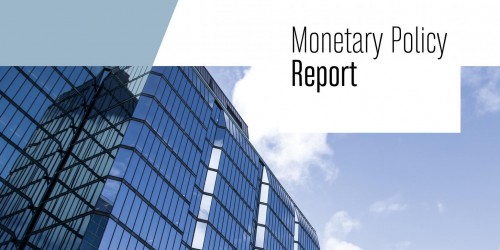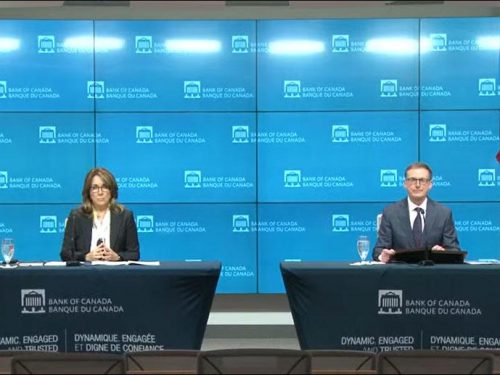Monetary Policy Report Press Conference Opening Statement
Good morning. I’m pleased to be here with you to discuss today’s policy announcement and the Bank of Canada’s Monetary Policy Report (MPR). I am especially pleased to have Senior Deputy Governor Carolyn Rogers here for her first press conference. She has joined the Governing Council at an important time.
Our message today is threefold.
First, the emergency monetary measures needed to support the economy through the pandemic are no longer required and they have ended.
Second, interest rates will need to increase to control inflation. Canadians should expect a rising path for interest rates.
Third, while reopening our economy after repeated waves of the COVID-19 pandemic is complicated, Canadians can be confident that the Bank of Canada will control inflation. We are committed to bringing inflation back to target.
Let me take each of these in turn.
The Bank’s response to the pandemic has been forceful. Throughout, our actions have been guided by our mandate. We have been resolute and deliberate, communicating clearly with Canadians on our extraordinary measures to support the economy and on the conditions for their exit. When we introduced emergency liquidity measures to support core funding markets, we said they would end when market functioning was restored. And they did. When we launched quantitative easing (QE), we said it would continue until the recovery was well underway. As the recovery progressed, we began tapering QE and ended it in October. Today marks the final step in exiting from emergency policies. We said exceptional forward guidance would continue until economic slack was absorbed. With the strength of the recovery through the second half of 2021, the Governing Council now judges this condition has been met. As such, we are removing our commitment to hold our policy rate at its floor of 0.25%.
Second, we want to clearly signal that we expect interest rates will need to increase. A lot of factors are contributing to the uncomfortably high inflation we are experiencing today, and many of them are global and reflect the unique circumstances of the pandemic. As the pandemic fades, conditions will normalize, and inflation will come down. However, with Canadian labour markets tightening and evidence of capacity pressures increasing, the Governing Council expects higher interest rates will be needed to bring inflation back to the 2% target.
Finally, Canadians can be assured that the Bank of Canada will control inflation. Prices for many goods and services are rising quickly, and this is making it harder for Canadians to make ends meet—particularly those with low incomes. Prices for food, gasoline and housing have all risen faster than usual. We expect inflation will remain close to 5% through the first half of 2022 and then move lower. There is some uncertainty about how quickly inflation will come down because we’ve never experienced a pandemic like this before. But Canadians can be assured that we will use our monetary policy tools to control inflation.
Let me turn to the economic outlook that we’ve outlined in our MPR.
Globally, the pandemic recovery is strong but uneven and continues to be marked by supply chain disruptions. Robust demand for goods combined with these supply problems and higher energy prices have pushed up global inflation. With this rise in inflation, expectations that monetary stimulus will be reduced have been pulled forward and financial conditions have tightened from very accommodative levels.
In Canada, growth in the second half of 2021 was even stronger than we had projected, and a wide range of measures now suggest economic slack is absorbed. With the rapid spread of the Omicron variant, first-quarter growth is likely to be modest, but we expect the impact on our economy to be less severe than previous waves. We forecast annual growth in economic activity will be 4% this year and about 3½% in 2023 as consumer spending on services rebounds and business investment and exports show solid growth.
CPI inflation is currently well above our target range and core measures have edged up. Global supply chain disruptions, weather-related increases in agricultural prices and high energy prices have put upward pressure on inflation in Canada, and that is expected to continue in the months ahead. These pressures should ease in the second half of 2022, and inflation should decline relatively quickly to around 3% by year end. Further out, we expect demand will moderate and supply will increase as productivity improves. This will ease price pressures and bring inflation gradually back close to the 2% target over 2023 and 2024.
Let me now say a few words about the Governing Council’s deliberations.
Of course, we discussed the impact of Omicron. Renewed restrictions and household caution about this highly infectious variant have temporarily slowed economic activity. Once again, high-contact services sectors have been hardest hit. But with many more Canadians getting infected in this wave, worker absences have been more widespread. Our high rates of vaccination and adaptability to restrictions should limit the downside economic risks of this wave.
The Governing Council also spent considerable time assessing the overall balance of demand and supply in the economy. In October, we projected the output gap would close sometime in the middle quarters of this year. While measuring the output gap is always uncertain and pandemic-related distortions make assessing supply more complicated, a broad range of indicators clearly suggest economic slack has been absorbed more quickly than expected. Employment is above pre-pandemic levels, businesses are having a hard time filling job openings, and wage increases are picking up. Unevenness across sectors remains, but taking all the evidence together, the Governing Council judges the economy is now operating close to its capacity.
We debated the most likely path for inflation. The resolution of global supply bottlenecks has important implications for inflation in Canada. There is some evidence that supply disruptions may have peaked, but the spread of Omicron is a new wildcard that could further disrupt global supply chains. We also considered the potential for some reversal of the large price increases for goods. This would pull inflation down more quickly than we forecast. Overall, we judged the risks around our inflation projection are reasonably balanced.
We also assessed more domestic sources of inflationary pressures. While global goods price inflation is expected to ease, the tightness in Canadian labour markets, rising house prices and evident capacity pressures suggest that if demand continues to grow faster than supply this will put upward pressure on inflation.
We noted that measures of inflation expectations are broadly in line with our own forecast, with longer-term expectations remaining well anchored on the 2% target. We agreed it is paramount to ensure that higher near-term inflation expectations don’t migrate into higher long-term expectations and become embedded in ongoing inflation.
Putting all this together, we concluded that, consistent with our forecast, a rising path for interest rates will be required to moderate spending growth and bring inflation back to target.
Of course, we discussed when to begin increasing our policy interest rate. Our approach to monetary policy throughout the pandemic has been deliberate, and we were mindful that the rapid spread of Omicron will dampen spending in the first quarter. So we decided to keep our policy rate unchanged today, remove our commitment to hold it at its floor, and signal that rates can be expected to increase going forward. As we indicated in our press release this morning, the timing and pace of those increases will be guided by the Bank’s commitment to achieving the 2% inflation target.
We take our communication with Canadians very seriously. For almost two years now we have told Canadians we would keep our policy rate pinned at its floor until economic slack is absorbed. With slack absorbed more quickly than expected, it is time to remove our extraordinary forward guidance. This ends our emergency policy setting and signals that interest rates will now be on a rising path. This is a significant shift in monetary policy, and we judged that it is appropriate to move forward in a deliberate series of steps.
Let me say a final word about another important monetary policy tool—our balance sheet. The Bank will keep the holdings of Government of Canada bonds on our balance sheet roughly constant at least until we begin to raise the policy interest rate. At that time, we will consider exiting the reinvestment phase and reducing the size of our balance sheet by allowing maturing Government of Canada bonds to roll off. As we have done in the past, before implementing changes to our balance sheet management, we will provide more information on our plans.
With that, Senior Deputy Governor Rogers and I will be happy to take your questions.


